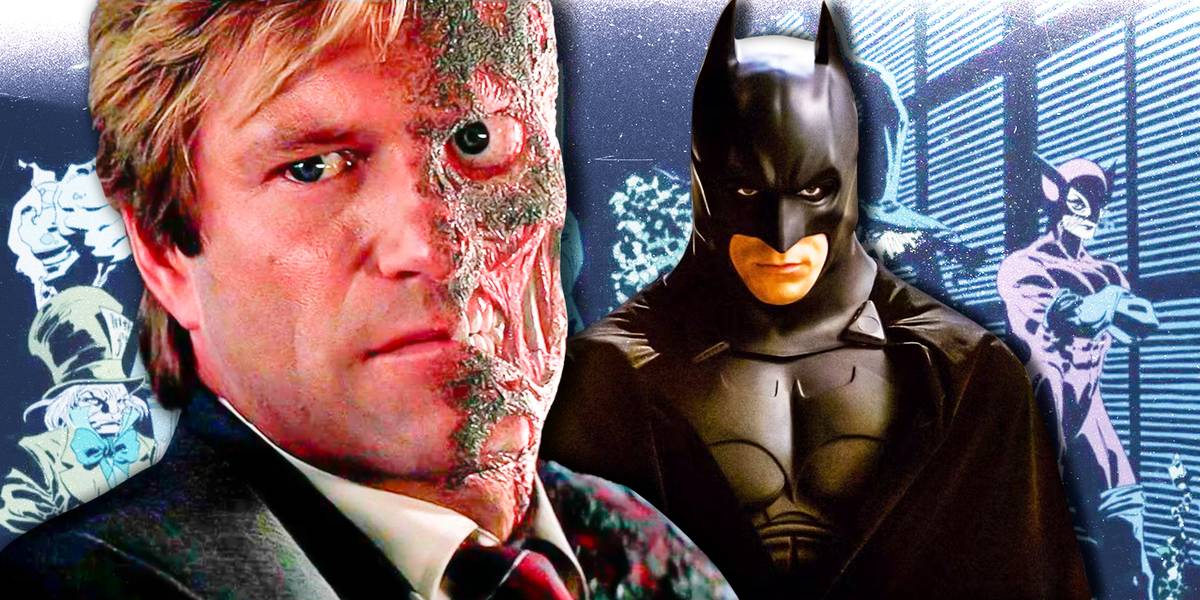[[{“value”:”
The word “definitive” is often thrown around online when it comes to historic comic characters like Batman and their best stories. DC Comics’ Dark Knight has a wealth of stories to pull from when it comes to standout comics, but The Long Halloween truly lives up to that label. Writer Jeph Loeb and the late artist Tim Sale did their best work in this 13-issue limited series, creating an engrossing, mobster-themed murder mystery that belongs in the same conversation as Frank Miller and David Mazzucchelli’s similarly iconic Year One.
While it’s not an origin story like Miller’s late ’80s arc, this early-years Batman arc feels like a milestone comic in showcasing the elements that define his Gotham City sandbox and his strengths as a superhero. It’s a narrative and tonal balance that has influenced some of the Caped Crusader’s best big-budget adaptations, from Christopher Nolan’s The Dark Knight to Matt Reeves’ recent The Batman. The way The Long Halloween blends crime-noir movie elements with the hero’s world combines for a timeless Batman comic for anyone who appreciates his reputation as a grizzled detective.
Related
The Smartest On-Screen Batman, Ranked By Their Detective Skills
Batman is the Dark Knight of Gotham, who is best known for his peak physical condition and gadgets, but his real power comes from his intelligence.
Batman, the World’s Greatest Detective
The Long Halloween Puts Batman’s Investigative Skills Up Front
Given The Long Halloween‘s timing, which is just a couple of years into Batman’s career, Jeph Loeb and Tim Sale’s comic doesn’t present a Dark Knight at the peak of his powers. But it certainly presents a capable Batman nonetheless, and one that allows the character’s roots as a pulpy superhero detective to be at the forefront. The beauty of the character is that he can fit into just about any genre and subgenre. But his “World’s Greatest Detective” tagline deserves just as much praise and attention as Batman’s action hero traits.
The Long Halloween unapologetically leans into Batman’s investigative skills to help drive the story as he and the GCPD’s Jim Gordon desperately follow the grisly trail of the “Holiday Killer.”
That doesn’t mean Loeb and Sale forget to include the more colorful aspects of Batman’s world and rogues gallery (with worldbuilding being another of The Long Halloween‘s strengths). But letting an enigmatic serial killer loose on the streets of Gotham City, leaving cryptic calling cards, and sparking a gang war is the perfect premise to pay homage to some of the Dark Detective’s fundamental building blocks as a protagonist.
The classic yet tastefully updated approach to the characterization of The Long Halloween‘s hero, even if the comic itself is nearly 30 years old, has given Batman and the story an evergreen quality within the character’s wider DC Comics canon. Loeb and Sale’s portrayal of a still-young, yet visibly more seasoned vigilante detective comes across like a natural progression from where readers see the protagonist begin in Year One.
He’s still allowed to struggle and be mentally tested—a crucial fallibility to ensure Batman still feels human—but is clearly making strides in being the last detective Gotham’s criminals want on their trail. In that respect, The Long Halloween very much seems like another successor to Miller’s story. It’s like a callback to the latter when a fledgling Dark Knight crashes a mobster dinner party, ominously promising them that their days are numbered. But in Loeb and Sale’s Batman arc, that has more than one meaning. Gotham’s mobs have to worry about a killer from their own circles in this mystery, and it won’t be long before the age of romanticized crime families ruling the city’s underworld is over.
Related
10 Best Batman Collected Edition Comics to Read in 2025
DC Comics continues to publish exciting Batman collections in 2025, from the first collected volume of Absolute Batman to classics like Year Three.
Loeb & Sale’s Batman Comic Balances Film-Noir With Superheroics
Batman’s Case is a Gritty Noir Case That Doesn’t Lose Sight of the Hero’s Mythos
The grit and darkness that fans today know modern Batman to be was set up in the early ’70s and has been widely popular since the ’80s. The Long Halloween will undoubtedly feel familiar to readers now in that regard—another testament to the comic’s timelessness. But this Batman arc remains the perfect read for fans who want a side of film noir with their heroics. It’s a delicate balance to achieve without resulting in a story that appears embarrassed to acknowledge its core as a superhero comic. And that’s thanks to the artistry of the late Tim Sale as much as it is Jeph Loeb’s crime drama.
To Loeb’s credit, he writes a riveting noir crime mystery for the hero to piece together that provides genuine surprises without letting the plot tie itself into knots.
The plot drips with film noir atmosphere, from its psychologically haunted protagonist to the suffocating tension that ramps up after each grim murder. The Long Halloween also brilliantly conveys how consequential these events are for Batman, Jim Gordon, and District Attorney Harvey Dent. This agonizing, year-long murder case’s ramifications truly make the character trio feel forever changed by the end of the story. These impressions are arguably just as lasting on them as they are on Gotham’s criminal status quo.
Few characters aside from Batman can slot into a crime-noir murder mystery involving the mafia, encounter a hulking zombie in the sewers, and stop a homicidal clown from dumping poison aboard a plane without feeling out of place. Meanwhile, Calendar Man, a once gimmick villain from the campier comics of the ’50s, is reinvented into a genuinely unnerving serial killer. The side villain even becomes the Silence of the Lambs-like Hannibal Lecter opposite Batman’s FBI agent Clarice Starling.
These are just a few cases of how well Loeb’s noir storytelling gels with the fantasy of the superhero genre. This mix of mobster-themed drama and superheroics is complemented by how The Long Halloween bridges the gap between “classical” organized crime and the larger-than-life supervillains in Batman’s rogues gallery that succeed it. This transition era isn’t wholly unique to this Batman comic. However, it’s an excellent contribution to The Long Halloween‘s plot and worldbuilding all the same.
Related
This is Scott Snyder’s Greatest Batman Comics Story Arc of All Time
Scott Snyder took on the Dark Knight in the New 52 and teamed up with Greg Capullo to introduce a dark new threat in one of Batman’s best story arcs.
But the writing is half the work at the end of the day, and Tim Sale’s striking artwork does a masterful job of tying all these elements visually. Sale is among the artists in DC Comics’ history whose work is instantly recognizable and irreplaceable. In The Long Halloween, his stylistic approach is a seamless fit for Loeb’s film-noir writing and depicts these characters in a unique light. Sale’s sharp, angular features, imposing physique, and the almost ghostly aesthetic of the Dark Detective’s cape make the character look more like a wraith than a man when he’s in the suit.
Still, the artist also illustrates Bruce Wayne’s lonesome humanity when he’s not under the cape and cowl, towering as he may be. This art direction stretches across the character roster and Gotham itself. The meticulous use of deep blues and blacks paints a picture of a Batman and Gotham City that stands apart visually even today.
The Long Halloween is a Noir Tragedy for an Iconic Rogue
This Batman Saga Also Presents the Fall of Harvey Dent & Rise of Two-Face
The psychological conflicts that many Batman comics present show how intriguing he is as a protagonist. The Long Halloween‘s use of internal monologues certainly adds to this and Jeph Loeb’s noir-heavy approach, but the hero’s rogues gallery is just as compelling.
This Batman arc understands this by making the story one part murder mystery, one part epic tragedy for one of his most iconic villains: Two-Face.
The Dark Knight fans will immediately recognize where the Nolan brothers and David Goyer found their inspiration for Aaron Eckhart’s Harvey Dent, as The Long Halloween chronicles the former D.A.’s camaraderie with Batman and Gordon to his cruel fall from grace.
This isn’t the first time Two-Face’s origins were explored in a more modernized light. The late and legendary creative duo of Dennis O’Neil and Neal Adams hold that honor for taking the villain more seriously in Batman #242, “Half an Evil.” Even so, The Long Halloween does a terrific job of fleshing out the three companions’ dynamic to make his inevitable corruption into Two-Face that much more gut-wrenching.
As Gotham City’s D.A., Harvey was one of the few people Bruce could allow himself to call a friend early in his career. This bond gives Two-Face a unique angle among Batman villains that even the Joker doesn’t have. His fall and overall arc are the final touches that make The Long Halloween such a well-rounded Batman comic. Tragedy is far from a foreign concept in the Dark Knight’s world, but Dent’s, combined with an immersive atmosphere and street-level story, gives weight to this period in Batman’s history.
“}]] While Jeph Loeb has left his mark on a number of comic characters, his work on Batman with the late Tim Sale on The Last Halloween still stands out. Read More

